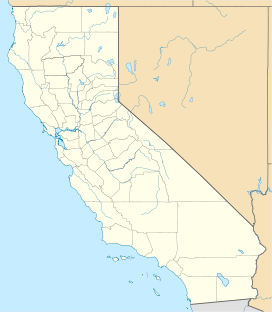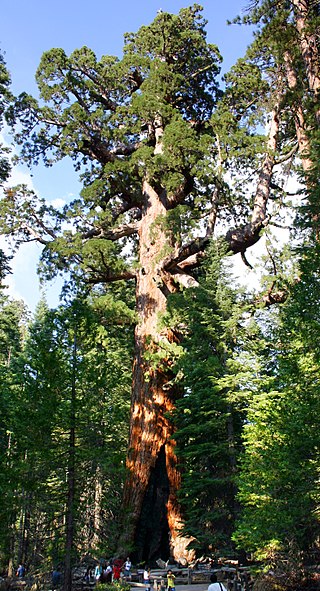
Sequoiadendron giganteum, also known as the giant sequoia, giant redwood or Sierra redwood is a coniferous tree, classified in the family Cupressaceae in the subfamily Sequoioideae. Giant sequoia specimens are the most massive trees on Earth. They occur naturally only in groves on the western slopes of the Sierra Nevada mountain range of California.

Kings Canyon National Park is an American national park in the southern Sierra Nevada, in Fresno and Tulare Counties, California. Originally established in 1890 as General Grant National Park, the park was greatly expanded and renamed on March 4, 1940. The park's namesake, Kings Canyon, is a rugged glacier-carved valley more than a mile (1,600 m) deep. Other natural features include multiple 14,000-foot (4,300 m) peaks, high mountain meadows, swift-flowing rivers, and some of the world's largest stands of giant sequoia trees. Kings Canyon is north of and contiguous with Sequoia National Park, and both parks are jointly administered by the National Park Service as the Sequoia and Kings Canyon National Parks.

Sequoia National Park is an American national park in the southern Sierra Nevada east of Visalia, California. The park was established on September 25, 1890, and today protects 404,064 acres of forested mountainous terrain. Encompassing a vertical relief of nearly 13,000 feet (4,000 m), the park contains the highest point in the contiguous United States, Mount Whitney, at 14,505 feet (4,421 m) above sea level. The park is south of, and contiguous with, Kings Canyon National Park; both parks are administered by the National Park Service together as the Sequoia and Kings Canyon National Parks. UNESCO designated the areas as Sequoia-Kings Canyon Biosphere Reserve in 1976.

Calaveras Big Trees State Park is a state park of California, United States, preserving two groves of giant sequoia trees. It is located 4 miles (6.4 km) northeast of Arnold, California in the middle elevations of the Sierra Nevada. It has been a major tourist attraction since 1852, when the existence of the trees was first widely reported, and is considered the longest continuously operated tourist facility in California.

The Giant Sequoia National Monument is a 328,000-acre (512 sq mi) U.S. National Monument located in the southern Sierra Nevada in eastern central California. It is administered by the U.S. Forest Service as part of the Sequoia National Forest and includes 38 of the 39 Giant Sequoia groves that are located in the Sequoia National Forest, about half of the sequoia groves currently in existence, including one of the ten largest Giant Sequoias, the Boole Tree, which is 269 feet (82 m) high with a base circumference of 112 feet (34 m). The forest covers 824 square miles (2,130 km2).

General Grant Grove, a section of the greater Kings Canyon National Park, was established by the U.S. Congress in 1890 and is located in Fresno County, California. The primary attraction of General Grant Grove is the giant sequoia trees that populate the grove. General Grant Grove's most well-known tree is called General Grant, which is 267 ft (81 m) tall and the third-largest known tree in the world. The General Grant tree is over 1,500 years old and is known as the United States' national Christmas tree. General Grant Grove consists of 154 acres (0.62 km2) and is geographically isolated from the rest of Kings Canyon National Park.

Sequoia National Forest is located in the southern Sierra Nevada mountains of California. The U.S. National Forest is named for the majestic Giant Sequoia trees which populate 38 distinct groves within the boundaries of the forest.
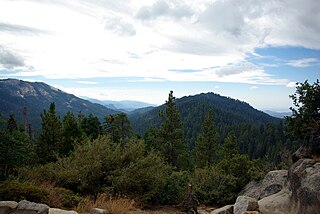
Redwood Mountain Grove is the largest grove of giant sequoia trees on earth. It is located in Kings Canyon National Park and Giant Sequoia National Monument on the western slope of California's Sierra Nevada. The grove contains the world's tallest giant sequoia. The Hart Tree and Roosevelt Tree grow in the grove and are two of the 25 largest trees by volume in the world. The largest tree is the General Sherman Tree in the Giant Forest grove to the southeast.

The Giant Forest, famed for its giant sequoia trees, is within the United States' Sequoia National Park. This montane forest, situated at over 6,000 ft (1,800 m) above mean sea level in the western Sierra Nevada of California, covers an area of 1,880 acres (7.6 km2). The Giant Forest is the most accessible of all giant sequoia groves, as it has over 40 mi (64 km) of hiking trails.

Mother of the Forest was a giant sequoia in the Sierra Nevada that was stripped of its bark and used as an exhibition tree. Discovered in 1852 by Augustus T. Dowd, it was the second largest tree in Calaveras Grove, standing at 328 feet tall with a circumference of 93 feet. During the California Gold Rush, its bark was harvested and exhibited in New York and London. However, the remaining tree was eventually destroyed by fire in 1908, leaving only a fire-blackened snag.

Converse Basin Grove is a grove of giant sequoia trees in the Giant Sequoia National Monument in the Sierra Nevada, in Fresno County, California, 5 miles (8 km) north of General Grant Grove, just outside Kings Canyon National Park. Once home to the second-largest population of giant sequoias in the world, covering 4,600 acres (19 km2) acres, the grove was extensively logged by the Sanger Lumber Company at the turn of the 20th century. The clearcutting of 8,000 giant sequoias, many of which were over 2,000 years old, resulted in the destruction of the old-growth forest ecosystem.

Mountain Home Grove is a grove of giant sequoia trees located in the southern part of the Sierra Nevada Mountains of California, and includes some of the largest trees in the world.

The Boole Tree is a giant sequoia in the Giant Sequoia National Monument, Fresno County, California. The Boole Tree is the eighth tallest sequoia in the world and is the largest in terms of base circumference at 113 feet. It is estimated to be more than 2,000 years old. The tree's stature is accentuated by its isolation above the Kings River where it towers over the rest of the forest.

The General Noble Tree was a monumental giant sequoia situated in the Converse Basin Grove, within the boundaries of the Giant Sequoia National Monument, in Fresno County, California. It was believed to be the biggest tree in the world before its felling in 1892 for an exhibit at the World's Columbian Exposition in Chicago. It was the largest tree ever felled.
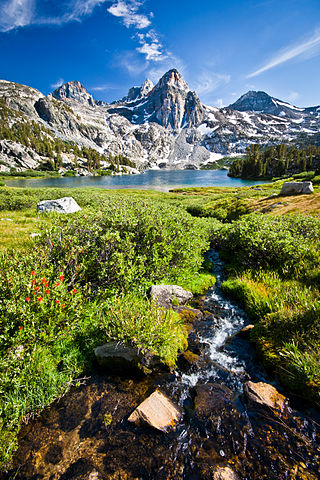
The Sequoia and Kings Canyon National Parks is the consolidated management structure for Sequoia National Park and Kings Canyon National Park in California. The two parks have been jointly administered since 1943. They have a combined size of 1,353 square miles (3,500 km2). It was designated the UNESCO Sequoia-Kings Canyon Biosphere Reserve in 1976.

The Mark Twain Tree was a giant sequoia tree located in the Big Stump Forest of Kings Canyon National Park. It was named after the American writer and humorist Mark Twain. It had a diameter of 4.8 meters when it was felled in 1891.
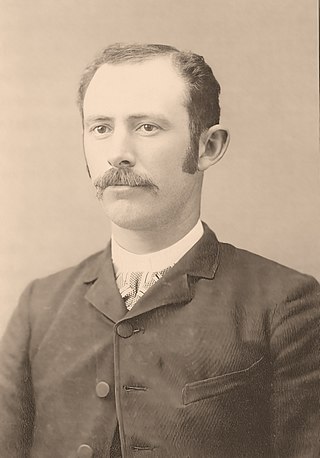
Charles Clifford Curtis (1862-1956) was a pioneering American photographer who is best remembered for his documentary photography of the logging industry in the Sierra Nevada mountains in the late 19th century. His photographs, which captured the felling of the famous Mark Twain Tree and the General Noble tree, helped to convince the public that these giant sequoias were not a hoax. Curtis was well-known for his use of large plate photography, which allowed him to capture portraits of people and gatherings that were dwarfed by the scale of the giant trees. His images of logging crews working in the rugged terrain of Converse Basin are considered some of the most iconic and enduring images of the era.

